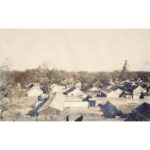Photography Inner City from Pingzemen gate Towards the East
A black-and-white photograph: panoramic view of one of the three parts of imperial Beijing, known as the Inner City (Neicheng 内城), which was located in the northern part of Beijing and surrounded the famous Forbidden City (Gugong 故宫 or Zijincheng 紫禁城). Parts of the city were separated from each other and from the rest of the world by walls. Three city gates were located on the western outer wall of the inner quarters.
Fucheng Gate (Fuchengmen 阜成門), called Pingze Gate (Pingzemen 平則門) in the Yuan Dynasty (1279–1368), stood on the southern part of the western wall of the inner quarters. Coal cargoes entered the city through it, as it was in close proximity to the Western Hills (Xishan 西山) and its rich coal deposits. Plum trees grew in front of the gate, blooming just at the time when the use of coal for winter heating ended. The beginning of spring and its pleasant warmth are associated in Beijing to this day with a saying consisting of two homophones ... more
A black-and-white photograph: panoramic view of one of the three parts of imperial Beijing, known as the Inner City (Neicheng 内城), which was located in the northern part of Beijing and surrounded the famous Forbidden City (Gugong 故宫 or Zijincheng 紫禁城). Parts of the city were separated from each other and from the rest of the world by walls. Three city gates were located on the western outer wall of the inner quarters.
Fucheng Gate (Fuchengmen 阜成門), called Pingze Gate (Pingzemen 平則門) in the Yuan Dynasty (1279–1368), stood on the southern part of the western wall of the inner quarters. Coal cargoes entered the city through it, as it was in close proximity to the Western Hills (Xishan 西山) and its rich coal deposits. Plum trees grew in front of the gate, blooming just at the time when the use of coal for winter heating ended. The beginning of spring and its pleasant warmth are associated in Beijing to this day with a saying consisting of two homophones – coal (mei 腐) plum blossom (mei 梅). They were also engraved on the Pingze Gate itself. An old Beijing proverb says, “The plum blossoms of Fucheng announce the arrival of new spring warmth”.
The photograph is the seventh of 449 photographs of Beijing and its surroundings in the album of Ivan Skušek Jr., purchased during his stay in Beijing (1914–1920). In the handwritten inventory of the album, the photograph is referred to as Tatarenstadt vom Ping-Tse-Men gegen Osten. (DZ)





































Do you have a comment or additional information about the subject?